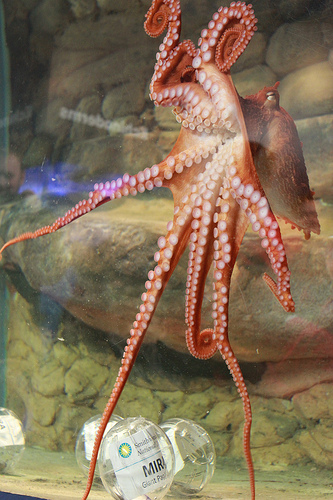National Zoo's Elderly Giant Pacific Octopus Dies
Pandora, the female giant Pacific octopus at the Smithsonian's National Zoo, died yesterday. Animal care staff estimate that Pandora was about 5 years old. The median lifespan for giant Pacific octopuses is about 3 to 5 years. Pandora came to the Zoo in November 2011 when she was about 1.5 years old. She lived at the Zoo's Invertebrate Exhibit for 27 months—longer than any of her predecessors. Pandora received her name shortly after her arrival at the Zoo. In conjunction with the Washington Post's KidsPost, Pandora's name was selected from hundreds of submissions from kids aged 5 to 15.
“Our staff, volunteers and visitors that know her by name were very fond of her,” said Tamsen DeWitt, a biologist at the Invertebrate Exhibit. “She was a terrific ambassador for her species. She was curious, charismatic and taught us so much about octopus behavior. We're happy she had such a long and healthy life.”
Both male and female octopuses die after breeding. Females lay thousands of eggs and protect them until they hatch. Pandora did not breed, but she laid unfertilized eggs in April 2013. Zoo curators had noticed a change in Pandora's behavior Feb. 10. She exhibited very little muscle tone and began lying at the bottom of her tank—common signs of old age in a cephalopod. A final pathology report will provide more information.
The giant Pacific octopus is the largest octopus species in the world. The octopuses emerge from eggs only a little larger than a grain of rice, but as adults can weigh hundreds of pounds, with an arm span of more than 12 feet. Pandora's arm span was 7.8 feet, and she weighed 15.4 lbs. Octopuses, like cuttlefish and squid, can change their skin texture and color as a defense, making them masters of camouflage.

